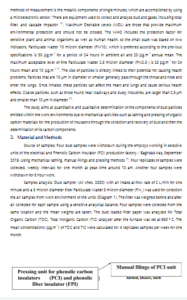Quantitative and qualitative measurement of carbon compounds in dust emitted in the work environment for electrical insulators production factory
Ali Shihab Ahmed
Hussein Mahmood Shukri
Zeina Tariq Salih
Collage of Biotechnology || Al-Nahrain University || Iraq
PDF
DOI
Tab title
A quantitative and qualitative determination of the pollutants emitted within the work environment, including dust and its components of organic and inorganic carbon was conducted in one of the factory of electrical insulators production. A dust sampler and 5 micron diameter filters were used and prepared for analysis in the carbon analyzer of organic and inorganic components. The result of the analysis shows the dust emissions concentrations of organic carbon (OC) in the mechanical lathing unit for cutting Phenolic Carbon Insulators (PCI) is (244.0 µg.m-3) and the lowest inorganic emissions (59.0 µg.m-3). The emission of manual filings from inorganic carbon dust is the highest concentration (916.0 µg.m-3) and the lowest organic carbon is (4.0 µg. m-3). The highest level for total inorganic carbon (TIC) in the manual unit fillings is (440.0 mg.m-3. .8hr-1) and the lowest TIC concentration is (2.8 mg.m-3. .8hr-1) in the mechanical lathing unit for phenolic carbon. While the highest level for OC in the mechanical lathing unit is (117.0 mg.m-3. .8hr-1) and the lowest OC concentration is (2.0 mg.m-3..8hr-1) in manual and pressing units. All concentrations of the dust and their components of organic and inorganic carbon are out of standards limitation of the International Standards Units (ISU). Exposure to these emissions during an actual working time of 8 hours a day requires commitments to individual and group safety measures to maintain workers safety. Keywords: Phenolic Carbon Insulators (PCI), Dust emission, Work environment, Organic carbon (OC), Inorganic carbon (IOC).
القياس الكمي والنوعي لمركبات الكربون في الغبار المنبعث في بيئة العمل لمصنع إنتاج العوازل الكهربائية
علي شهاب أحمد
حسين محمود شكري
زينة طارق صالح
كلية التقنيات الأحيائية || جامعة النهرين || العراق
Tab title
تم إجراء تحديد كمي ونوعي للملوثات المنبعثة في بيئة العمل، بما في ذلك الغبار ومكوناته من الكربون العضوي وغير العضوي في أحد مصانع إنتاج العوازل الكهربائية. استخدمت مرشحات قطرها 5 ميكرون لتجميع الغبار المنبعث وتحضيرها في محلل الكربون للمكونات العضوية وغير العضوية. نتائج التحليل أظهرت وجود نسبة عالية من انبعاث الغبار ومكوناته من انبعاثات الكربون العضوية وغير العضوية في وقت الذروة لجميع أماكن العمل في وحدات مختارة. حيث بلغت الإيداعات ( 244.0 مايكروغرام.م-3 ) وأقل قراءة ( 59.0 مايكروغرام.م-3. ). الإيداعات اليدوية سجلت تراكيز عالية من الكربون العضوي حيث بلغت ( 916.0 مايكروغرام.م-3 ) وأقل قيمة (4.0 مايكروغرام.م-3). كانت أعلى تراكيز للكاربون غير العضوي الكلي باستخدام الايداع اليدوي خلال يوم كامل للعمل /8 ساعات ( 440.0 ملي غرام.متر-1 .8 ساعة-1) وأقل تركيز (2.8 ملي غرام.متر-1 .8 ساعة-1 ) . وكان اعلى تركيز للكاربون العضوي (117.0 ملي غرام.متر-1 .8 ساعة-1 ) وأقل تركيز (2.0 ملي غرام.متر-1 .8 ساعة-1 ).خلال الإيداعات اليدوية والآلية. جميع تركيزات الغبار ومكوناته من الكربون العضوي وغير العضوي هي خارج حدود المعايير القياسية الدولية. التعرض لهذه الانبعاثات خلال وقت عمل فعلي قدره 8 ساعات في اليوم يتطلب التزامات بتدابير السلامة الفردية والجماعية للحفاظ على سلامة العاملين. الكلمات المفتاحية: عوازل الكاربون الفينولية, انبعاث الغبار , بيئة العمل , الكاربون العضوي , كاربون لا عضوي.
For more than 200 years, chemists have divided carbon compounds into two groups. Those that were isolated from nature (plants or animals) were called organic carbon compounds, while those extracted from a biotic and minerals were inorganics. Compounds are those which contain carbon, although some carbon-containing compounds are traditionally regarded inorganic. Over the century ago, the accurate classification of inorganic and. organic compounds has become less important, primarily because the majority of known carbon compounds are synthetic and not of natural source. [1]
Air pollution is polluted of the indoor or outdoor environment by any chemical, physical or biological agents that modify the natural characteristics of the atmosphere. Household fuel combustion, motor vehicles, industrial facilities and forest fires are common sources of air pollution. Pollutants of major public health concern consist of particulate matter, carbon monoxide (CO), ozone (O3), nitrogen dioxide (NO2) and sulfur dioxide (SO2) [2].
This indoor environment is often contaminated with differences air pollutants; the concentration of these pollutants may reach high peak levels due to the small spatial size. Indoor air in cities has been reported to be as much as 100 times more polluted than that outdoors [3] .Typical average concentration of organic carbon (OC) in the atmosphere are in the range of 1 μg.m-3 in clean places to 10 μg.m-3 in polluted areas, whereas peak concentrations might reach 50 μg.m-3 during biomass burning accidences. Elemental carbon concentrations in clean areas are typically around of 1 μg.m-3, in polluted areas they might exceed 5 μg.m-3 [4]. Small dust particles remain stuck in the air for a long time by the viscosity or resistance of the air, which resists any force to settle the plankton and the particles. Minutes are separated from the air over time, and the techniques used reduce the time required to precipitate, so dust is defined as a diffuse spray with solid minutes [5]. A single spray is composed of many chemical compounds but chemical analysis is difficult because of the amount of material to be analyzed. One of the successful methods of







